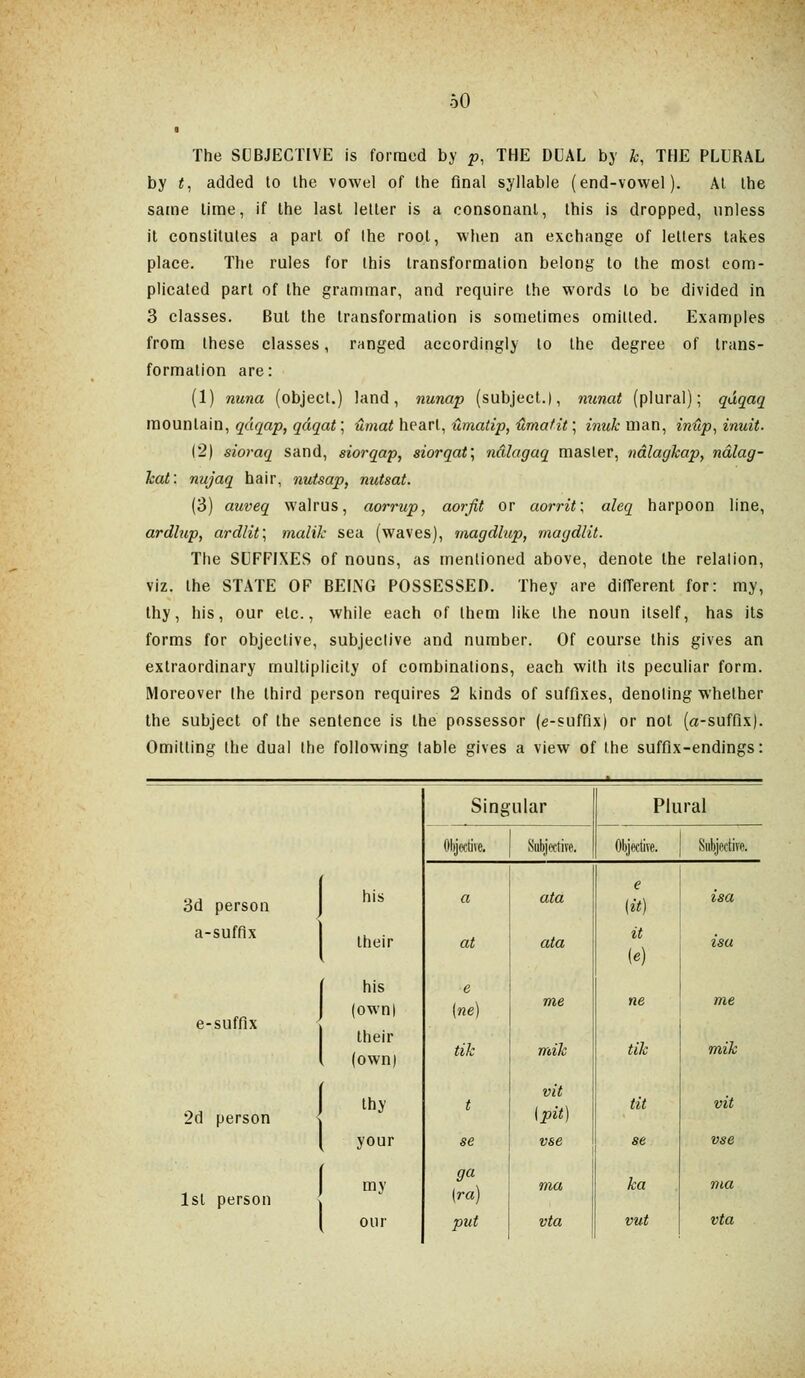
Full resolution (JPEG) - On this page / på denna sida - II. The Eskimo language, its admirable organisation as to the construction and flexion of words - Nouns and their flexion

<< prev. page << föreg. sida << >> nästa sida >> next page >>
Below is the raw OCR text
from the above scanned image.
Do you see an error? Proofread the page now!
Här nedan syns maskintolkade texten från faksimilbilden ovan.
Ser du något fel? Korrekturläs sidan nu!
This page has been proofread at least once.
(diff)
(history)
Denna sida har korrekturlästs minst en gång.
(skillnad)
(historik)
The SUBJECTIVE is formed by p, THE DUAL by k, THE PLURAL
by t, added to the vowel of the final syllable (end-vowel). At the
same time, if the last letter is a consonant, this is dropped, unless
it constitutes a part of the root, when an exchange of letters takes
place. The rules for this transformation belong to the most
complicated part of the grammar, and require the words to be divided in
3 classes. But the transformation is sometimes omitted. Examples
from these classes, ranged accordingly to the degree of
transformation are:
(1) nuna (object.) land, nunap (subject.), nunat (plural); qáqaq
mountain, qáqap, qáqat; ûmat heart, ûmatip, ûmatit; inuk man, inûp, inuit.
(2) sioraq sand, siorqap, siorqat; nâlagaq master, nâlagkap,
nâlagkat; nujaq hair, nutsap, nutsat.
(3) auveq walrus, aorrup, aorfit or aorrit; aleq harpoon line,
ardlup, ardlit; malik sea (waves), magdlup, magdlit.
The SUFFIXES of nouns, as mentioned above, denote the relation,
viz. the STATE OF BEING POSSESSED. They are different for: my,
thy, his, our etc., while each of them like the noun itself, has its
forms for objective, subjective and number. Of course this gives an
extraordinary multiplicity of combinations, each with its peculiar form.
Moreover Ihe third person requires 2 kinds of suffixes, denoting whether
the subject of the sentence is the possessor (e-suffix) or not (a-suffix).
Omitting the dual the following table gives a view of the suffix-endings:
| Singular | Plural
|
||||||
| Objective. | Subjective. | Objective. | Subjective. | ||||
| 3d person a-suffix | his | a | ata | e (it) | isa | ||
| their | at | ata | it (e) | isa | |||
| e-suffix | his (own) | e (ne) | me | ne | me | ||
| their (own) | tik | mik | tik | mik | |||
| 2d person | thy | t | vit (pit) | tit | vit | ||
| your | se | vse | se | vse | |||
| 1st person | my | ga (ra) | ma | ka | ma | ||
| our | put | vta | vut | vta | |||
<< prev. page << föreg. sida << >> nästa sida >> next page >>